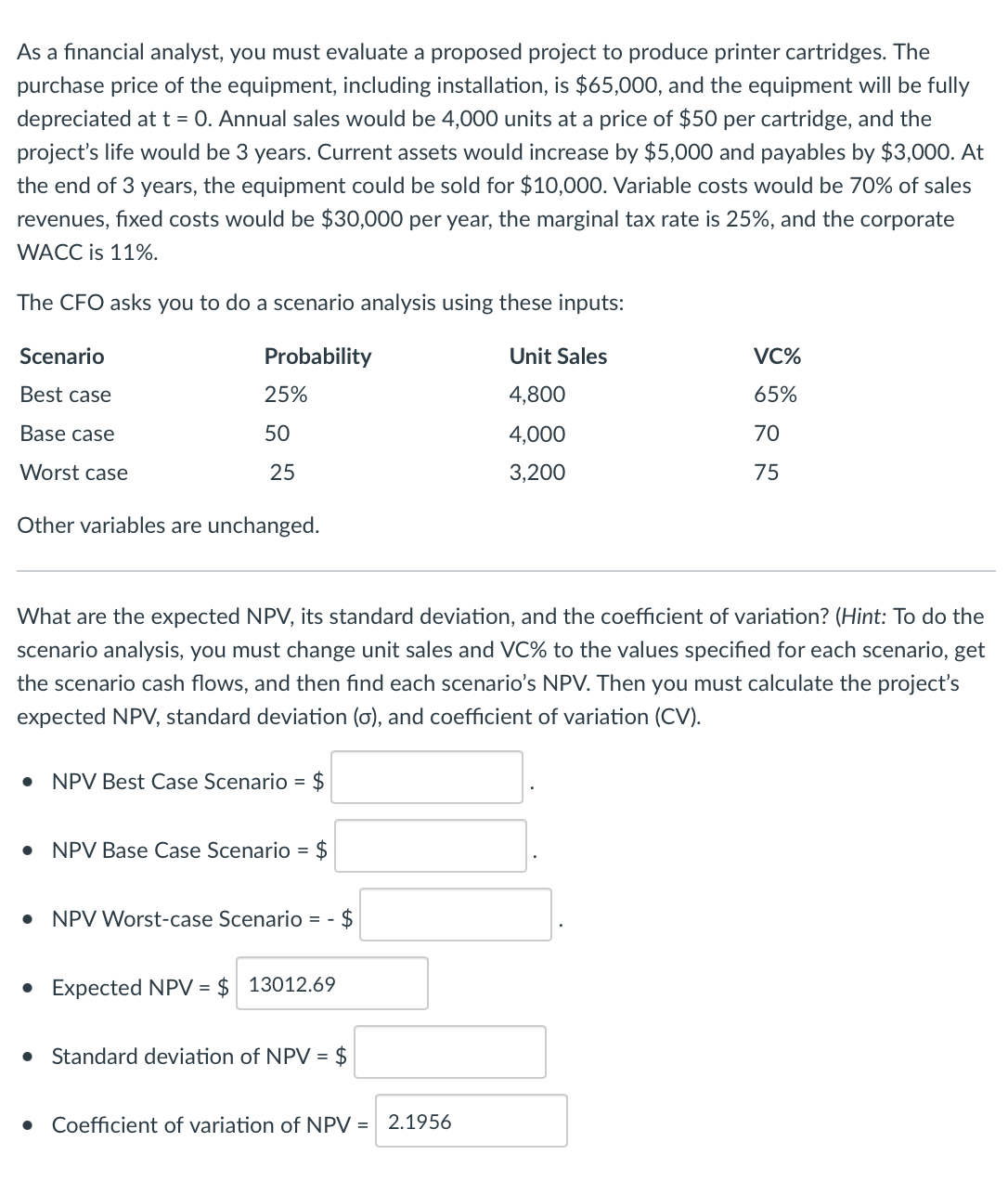As a financial analyst, you must evaluate a proposed project to produce printer cartridges. The purchase price of the equipment, including installation, is $65,000, and the equipment will be fully depreciated att = 0. Annual sales would be 4,000 units at a price of $50 per cartridge, and the project's life would be 3 years. Current assets would increase by $5,000 and payables by $3,000. At the end of 3 years, the equipment could be sold for $10,000. Variable costs would be 70% of sales revenues, fixed costs would be $30,000 per year, the marginal tax rate is 25%, and the corporate WACC is 11%. The CFO asks you to do a scenario analysis using these inputs: Scenario Probability Unit Sales VC% Best case 25% 4,800 65% Base case 50 4,000 70 Worst case 25 3,200 75 Other variables are unchanged. What are the expected NPV, its standard deviation, and the coefficient of variation? (Hint: To do the scenario analysis, you must change unit sales and VC% to the values specified for each scenario, get the scenario cash flows, and then find each scenario's NPV. Then you must calculate the project's expected NPV, standard deviation (o), and coefficient of variation (CV). • NPV Best Case Scenario = $ NPV Base Case Scenario = $ • NPV Worst-case Scenario = -
As a financial analyst, you must evaluate a proposed project to produce printer cartridges. The purchase price of the equipment, including installation, is $65,000, and the equipment will be fully depreciated att = 0. Annual sales would be 4,000 units at a price of $50 per cartridge, and the project's life would be 3 years. Current assets would increase by $5,000 and payables by $3,000. At the end of 3 years, the equipment could be sold for $10,000. Variable costs would be 70% of sales revenues, fixed costs would be $30,000 per year, the marginal tax rate is 25%, and the corporate WACC is 11%. The CFO asks you to do a scenario analysis using these inputs: Scenario Probability Unit Sales VC% Best case 25% 4,800 65% Base case 50 4,000 70 Worst case 25 3,200 75 Other variables are unchanged. What are the expected NPV, its standard deviation, and the coefficient of variation? (Hint: To do the scenario analysis, you must change unit sales and VC% to the values specified for each scenario, get the scenario cash flows, and then find each scenario's NPV. Then you must calculate the project's expected NPV, standard deviation (o), and coefficient of variation (CV). • NPV Best Case Scenario = $ NPV Base Case Scenario = $ • NPV Worst-case Scenario = -
Chapter19: Lease And Intermediate-term Financing
Section: Chapter Questions
Problem 8P
Related questions
Question

Transcribed Image Text:As a financial analyst, you must evaluate a proposed project to produce printer cartridges. The
purchase price of the equipment, including installation, is $65,000, and the equipment will be fully
depreciated at t = 0. Annual sales would be 4,000 units at a price of $50 per cartridge, and the
project's life would be 3 years. Current assets would increase by $5,000 and payables by $3,000. At
the end of 3 years, the equipment could be sold for $10,000. Variable costs would be 70% of sales
revenues, fixed costs would be $30,000 per year, the marginal tax rate is 25%, and the corporate
WACC is 11%.
The CFO asks you to do a scenario analysis using these inputs:
Scenario
Probability
Unit Sales
VC%
Best case
25%
4,800
65%
Base case
50
4,000
70
Worst case
25
3,200
75
Other variables are unchanged.
What are the expected NPV, its standard deviation, and the coefficient of variation? (Hint: To do the
scenario analysis, you must change unit sales and VC% to the values specified for each scenario, get
the scenario cash flows, and then find each scenario's NPV. Then you must calculate the project's
expected NPV, standard deviation (o), and coefficient of variation (CV).
NPV Best Case Scenario =
$
• NPV Base Case Scenario = $
NPV Worst-case Scenario = -
$
• Expected NPV = $ 13012.69
Standard deviation of NPV = $
• Coefficient of variation of NPV = 2.1956
Expert Solution
This question has been solved!
Explore an expertly crafted, step-by-step solution for a thorough understanding of key concepts.
This is a popular solution!
Trending now
This is a popular solution!
Step by step
Solved in 3 steps

Knowledge Booster
Learn more about
Need a deep-dive on the concept behind this application? Look no further. Learn more about this topic, accounting and related others by exploring similar questions and additional content below.Recommended textbooks for you

EBK CONTEMPORARY FINANCIAL MANAGEMENT
Finance
ISBN:
9781337514835
Author:
MOYER
Publisher:
CENGAGE LEARNING - CONSIGNMENT


Intermediate Financial Management (MindTap Course…
Finance
ISBN:
9781337395083
Author:
Eugene F. Brigham, Phillip R. Daves
Publisher:
Cengage Learning

EBK CONTEMPORARY FINANCIAL MANAGEMENT
Finance
ISBN:
9781337514835
Author:
MOYER
Publisher:
CENGAGE LEARNING - CONSIGNMENT


Intermediate Financial Management (MindTap Course…
Finance
ISBN:
9781337395083
Author:
Eugene F. Brigham, Phillip R. Daves
Publisher:
Cengage Learning

Cornerstones of Cost Management (Cornerstones Ser…
Accounting
ISBN:
9781305970663
Author:
Don R. Hansen, Maryanne M. Mowen
Publisher:
Cengage Learning


Principles of Accounting Volume 2
Accounting
ISBN:
9781947172609
Author:
OpenStax
Publisher:
OpenStax College